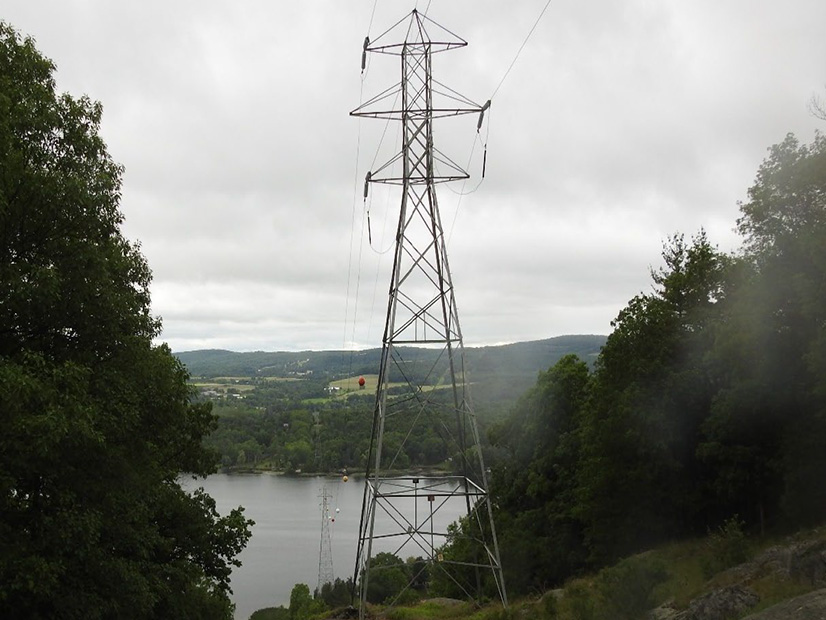Eversource Outlines Rebuilding, Replacement Projects
Eversource Energy put forward a pair of transmission projects to the ISO-NE Planning Advisory Committee on Wednesday, including one in Connecticut to replace several lattice towers that are nearly 100 years old.
Line 690 is a 69-kV line that spans 1.87 miles from the Salisbury 21J substation in Northwest Connecticut to the New York border and consists of 11 lattice towers installed in 1926 that are among the oldest on the utility’s system, according to Eversource’s Chris Soderman.
Inspections revealed significant foundation damage, hardware rust and broken bells. Engineering analysis indicated that the current structures could not support the weight of reconductoring because of hardware rust, missing bolts, bent members and deteriorated metal at the structures’ base. The replacement for the conductor is 20% heavier.
Soderman said Eversource would rebuild 1.59 miles of Line 690 with 10 single-circuit lattice tower structures with single-circuit steel monopole structures. The utility will also replace conductors and shield wire. One lattice tower and 0.28 miles of conductors will remain in place until a future project to replace them is coordinated with Central Hudson Gas and Electric in New York. Line 690 will continue at 69 kV but configured for future operation at 115 kV. The project’s estimated cost is $11 million, with an in-service date in the second quarter of 2022.
The second effort is an addition to a December 2019 project. It identifies four additional projects based on recent inspections of 115-kV and 230-kV wood poles in Connecticut, Massachusetts and New Hampshire, plus a modified 2019 project, which ultimately replaced 208 structures.
Inspections show systemwide degradation, and replacing the structures resolves multiple structural and hardware issues. System data and recent hardware failures show a need for shield wire replacements. The existing shield wire consists of outdated industry materials with associated replacement hardware that is now obsolete. Replacing it allows for updated hardware, continued line shielding and increased communication and reliability throughout the system. All replacements and upgrades will be designed to meet current design criteria.
The proposed in-service dates range from the third quarter of 2021 to the fourth quarter of 2022 at an estimated $65 million.
Regional System Plan Updates
Kannan Sreenivasachar, ISO-NE’s technical manager for transmission planning, updated the PAC on the Regional System Plan, which details power system needs and resource and transmission facilities needed to maintain the grid’s reliability over a 10-year horizon. According to its tariff, the RTO must develop an RSP at least once every three years.
Among the highlights of the transmission project list were three significant downward cost estimate changes from the last update in March:
- A reduction of $14.6 million on the Seafood Way 115-kV substation in South Boston, Mass., reflects approved pool transmission facility (PTF) costs.
- Seacoast New Hampshire Solution will cost $12 million less to mirror updated PTF costs.
- The Rhode Island portion of Eastern CT 2029 saw its price tag drop $8.9 million following the removal of asset condition costs from the total estimated costs.
One project since March in Massachusetts was also canceled — installation of a 115-kV breaker at the North Oxford substation and segmentation of the V-174 line — saving an estimated $3 million, as it is no longer needed.
Sreenivasachar added that Greater Boston-Central was the only project to change to in-service status after resolving thermal overloads.
The asset condition list featured eight new projects at an estimated $157.3 million, and 13 projects moved to in-service status.
Preliminary Results from Tx Planning Pilot Study
ISO-NE’s Dan Schwarting, Andrew Kniska and Meenakshi Saravanan presented preliminary results from the RTO’s “Transmission Planning for the Clean Energy Transition” pilot study, which tested grid performance assumptions under high renewable penetration scenarios and quantified the tradeoffs between transmission investment and less system flexibility. The results could also inform future transmission needs assessments.
The goal was to identify the overall trend of system behavior and reliability concerns as more renewables are brought online, not to determine exact needs or potential upgrades. Thus, base cases represented a likely dispatch for a given condition rather than stressing any specific portion of the system through generator outages.
Some of the takeaways include:
- Steady-state N-1 qualitative results showed marginally high voltages in Maine attributable to increased wind in Scenario 1. In addition, increased solar in Scenario 3 led to lower amounts of synchronous generation online, reducing voltage control.
- Steady-state N-1-1 qualitative results for three minimum load scenarios had high voltages in Connecticut (1 and 3) and Maine (1-3), with more wind and solar leading to less synchronous generation online, reducing voltage control.
ISO-NE said it would provide more precise detail in future presentations and reports, but likely not at a typical Needs Assessment level.


